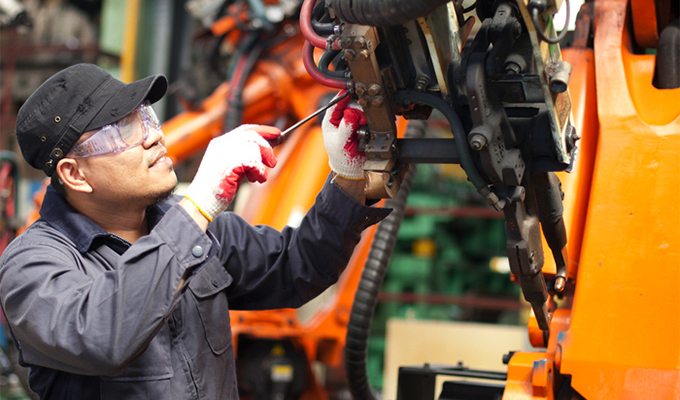Innovative construction equipment maintenance processes and training programs can minimize downtime and maximize the value of your equipment. Every piece of heavy equipment requires maintenance from time to time. It does not have to result in lengthy, expensive downtime, though. You can transform how your team handles maintenance and repairs with a few key strategies.
Prevent Breakdowns
Heavy equipment breakdowns are expensive and time-consuming, but predictive maintenance and effective training can prevent them. Breakdowns are frequently the result of an internal issue that went unresolved for an extended period. If you address developing problems early, you can stop them from causing a breakdown.
Research shows predictive maintenance can prevent up to 75% of heavy equipment breakdowns. Of course, it requires completing repairs and monitoring performance. However, these processes require far less time than the downtime machine failure causes.
Training can empower employees to help with predictive heavy equipment maintenance. Vehicle operators often are not aware of early warning signs for malfunctions and mechanical issues. You can provide training on identifying red flags and utilizing diagnostic equipment. This will ensure your team has the knowledge to help identify developing maintenance problems.
Remember—even experienced team members probably have not used every piece of equipment on-site before. They may be uncomfortable asking for help, though. Training allows new and old team members to learn valuable new skills in a stress-free environment.
Minimize Repair Time
Construction equipment maintenance is a necessary part of operating vehicles on your site. It does not have to be time-consuming, though. Predictive maintenance and simple repair training can minimize the time every repair takes so you can maximize uptime.
Some team members are experts in performing maintenance, but it is helpful for everyone on your team to have some basic skills. This knowledge will help increase awareness of developing issues and allow more employees to perform repairs simultaneously.
Thorough skills training will also enable your team members to complete repairs in less time without risk of errors. They will be more confident in their mechanical skills, and less likely to need help from guides or other team members.
Encourage Safe Operating Practices
All on-site workers play a role in eliminating equipment downtime. The way workers use and drive machines can help prevent breakdowns. However, your team members might not be aware certain operating practices are unsafe and may damage equipment.
You can resolve this by creating on-site training programs that teach safe, efficient operating practices. This is a great opportunity for your team to build their skills and learn techniques for improving performance on the job. For example, they might not know minimizing time on slopes can prevent track wear on excavators. Picking up knowledge like this encourages safety and reduces the risk of accidental equipment damage.
Additionally, it is vital to maintain open communication with your machine operators, particularly those who are new to construction. Encourage your team to ask questions if they need help identifying maintenance issues or safely using equipment.
Strong communication on-site can go a long way toward preventing reckless or improper equipment operation. It also shows your team you care about their safety on the job, which is vital for building a supportive workplace culture.
Standardize Maintenance Processes
Excessive downtime can result from inconsistent maintenance processes, such as two team members attempting to do the same repair differently. Clashing maintenance processes can also inadvertently worsen internal issues rather than resolve them.
Training is essential for ensuring these problems do not occur. It lets you inform your team exactly how you expect them to perform heavy equipment maintenance and inspections. When everyone uses the same steps for repairs, they are more likely to perform correctly, notice mistakes, and finish repairs quickly.
Monitor Downtime and Optimize Utilization
Predictive maintenance requires continuous monitoring using telematics devices like IoT sensors. Investing in this gear can deliver an excellent ROI since it helps reduce downtime and improve equipment utilization.
Continuous monitoring increases visibility and builds a large data set of performance metrics. This data is invaluable for finding ways to improve how your team uses equipment, which can reduce downtime. For example, fleet telematics data can help you identify unsafe operating behaviors that may be contributing to breakdowns.
You can use this information to design or improve your training programs. It can also reveal equipment operation trends, such as the frequency of failures or the types of equipment that experience the most downtime. This data can aid in predictive maintenance by helping you pinpoint the most risk-prone tools and vehicles.
Revolutionizing Construction Equipment Maintenance
You can take steps to reduce downtime on-site and get more value out of your construction equipment. Predictive maintenance and job site training can go a long way toward preventing expensive, time-consuming breakdowns.
Training gives your team the skills, knowledge, and confidence to operate and care for machines effectively. Meanwhile, predictive heavy equipment maintenance will improve visibility and help you spot mechanical issues sooner. With these strategies, you can minimize downtime so your team can make the most of every minute on the job.
About the Author
Emily Newton is an industrial writer who specializes in covering how technology is disrupting industrial sectors. She’s also the editor-in-chief of Revolutionized where she covers innovations in industry, construction, and more.


